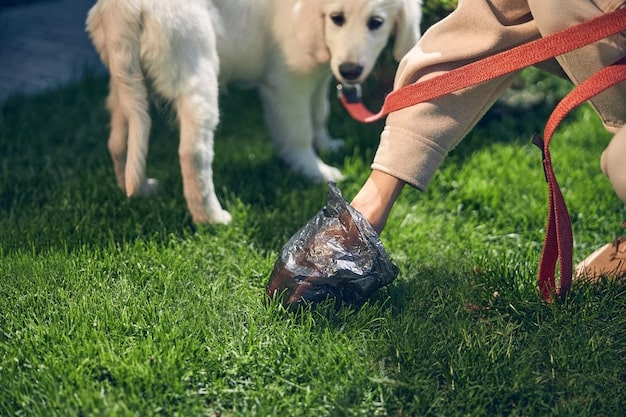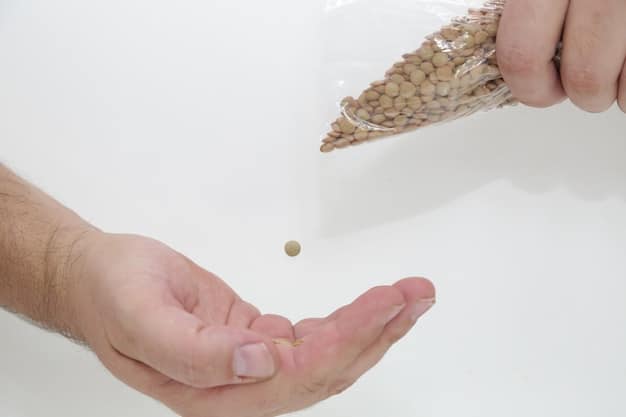Sustainable Pet Care: Eco-Friendly Tips for a Greener Pet Lifestyle

Sustainable pet care involves adopting eco-friendly practices in feeding, grooming, waste management, and choosing pet products to minimize your pet’s environmental impact and contribute to a healthier planet.
Embracing sustainable pet care is crucial in today’s world, where environmental consciousness is paramount; find effective tips on how to reduce your pet’s environmental impact, ensuring a healthier planet for future generations of both humans and animals.
Understanding Your Pet’s Environmental Impact
Pets bring immense joy and companionship to our lives, but it’s important to acknowledge their environmental footprint. Understanding the impact of pet ownership on the environment is the first step toward making more sustainable choices. From food consumption to waste production, our furry friends contribute to environmental challenges, but we can mitigate these effects with conscious effort.
The ecological impact of pets results from the resources required to sustain them, including food production, the manufacture of pet products, and waste disposal. Awareness of these elements allows pet owners to make eco-friendly choices, decreasing their overall impact on the planet.
Food Production and Its Impact
The pet food industry significantly contributes to environmental issues, primarily through the resources needed for meat production. The meat-based diets of many pets lead to high carbon emissions, deforestation, and water usage. Choosing alternative protein sources can help mitigate these effects.
Waste Management Concerns
Pet waste is a significant source of pollution, introducing harmful bacteria and nutrients into the ecosystem. Traditional plastic waste bags are non-biodegradable and contribute to landfill overflow. Sustainable waste management practices are essential for reducing your pet’s environmental paw print.

Here are some sustainable options to consider:
- Compostable Waste Bags: Opt for bags made from biodegradable materials that break down naturally.
- Proper Disposal: Always dispose of pet waste properly to prevent contamination of water sources.
- Consider Composting: Research local regulations and consider composting pet waste in a designated compost bin.
By understanding these impacts, pet owners can proactively take steps toward a more sustainable lifestyle. This awareness forms the foundation for adopting eco-friendly practices that benefit both our pets and the environment.
Choosing Eco-Friendly Pet Food
Selecting sustainable food options is among the most impactful ways to reduce your pet’s environmental footprint. Understanding the sourcing, ingredients, and packaging of pet food can help you make informed decisions that align with eco-friendly practices. Eco-friendly pet food focuses on sustainably sourced components and eco-conscious packaging.
Sustainable pet food aims to reduce the negative environmental impacts linked to traditional pet food production, promoting more accountable and environmentally friendly practices.
Sustainable Ingredients
Look for pet food that incorporates sustainably sourced ingredients. This includes proteins from environmentally responsible farms and fisheries, as well as plant-based components produced through sustainable agriculture. These choices lower the environmental impact related to food production.
Alternative Protein Sources
Consider pet foods that feature alternative protein sources, such as insect-based proteins or plant-based proteins. Insect protein, for instance, demands less land, water, and feed in comparison to traditional livestock farming. These alternatives can considerably lower the carbon footprint of your pet’s diet.
- Insect-Based Proteins: Pet food made with insects is a novel and sustainable option.
- Plant-Based Proteins: Look for pet food that includes plant-based proteins from sources like peas, lentils, and chickpeas.
- Responsibly Sourced Meat: When choosing meat-based options, opt for brands that prioritize ethical and sustainable farming practices.
Choosing eco-friendly pet food not only minimizes your pet’s environmental impact but also supports ethical and sustainable food production practices. By making these informed choices, you contribute to a healthier planet for both animals and humans.

Eco-Friendly Grooming Practices
Grooming is an essential part of pet care, but traditional routines can impact the environment. Embracing eco-friendly grooming practices can significantly reduce your pet’s environmental paw print by using sustainable products and minimizing waste.
Eco-friendly grooming involves using products with natural ingredients, reducing water usage, and minimizing plastic waste. These practices ensure that your pet stays clean and healthy while also protecting the planet.
Natural and Organic Products
Opt for grooming products made with natural and organic ingredients. Shampoos, conditioners, and other grooming aids that are free from harsh chemicals and synthetic fragrances are better for your pet’s skin and the environment. These products often come in biodegradable packaging.
Water Conservation Tips
Conserving water is crucial during grooming sessions. Use water-saving techniques such as spot cleaning, dry shampoos, and efficient rinsing methods to minimize water usage. Bathing your pet only when necessary can also help conserve water.
Here are several methods to consider:
- Spot Cleaning: Use a damp cloth to clean specific areas instead of a full bath.
- Dry Shampoos: Apply dry shampoo to absorb dirt and oil without water.
- Efficient Rinsing: Use a low-flow showerhead and rinse thoroughly in one go.
Transitioning to eco-friendly grooming practices not only benefits the environment but also promotes your pet’s well-being. By making conscious choices in grooming products and techniques, you can ensure a sustainable and healthy lifestyle for your beloved companion.
Sustainable Pet Toys and Accessories
The toys and accessories we provide for our pets can significantly contribute to their environmental paw print. Choosing sustainable options made from eco-friendly materials can reduce waste and minimize the impact on the planet. Toys and accessories made from sustainable materials are durable and safe for our pets.
Sustainable pet products prioritize natural, recycled, and biodegradable materials, ensuring that your pet’s belongings are both environmentally friendly and long-lasting.
Materials to Look For
When selecting pet toys and accessories, look for items made from materials such as recycled plastic, bamboo, hemp, and organic cotton. These materials are renewable, biodegradable, and often produced with minimal environmental impact. Avoid products made from synthetic materials that contribute to pollution.
DIY Pet Toys
Creating your pet toys from household items is a fun and sustainable way to reduce waste. Old t-shirts, socks, and cardboard boxes can be repurposed into engaging and safe toys for your furry friend. This approach encourages creativity and reduces the demand for new products.
Consider these simple DIY ideas:
- T-Shirt Braids: Cut old t-shirts into strips and braid them together to create durable tug toys.
- Sock Puppets: Fill old socks with stuffing and sew them closed to make simple puppets.
- Cardboard Castles: Transform cardboard boxes into elaborate castles or tunnels for your pets.
Opting for sustainable pet toys and accessories demonstrates your commitment to environmental responsibility. By choosing eco-friendly options and engaging in DIY projects, you can provide your pet with enriching experiences while minimizing their environmental footprint.
Managing Pet Waste Sustainably
Proper pet waste management is essential for maintaining a clean and healthy environment. Traditional disposal methods often involve plastic bags that contribute to landfill waste. Adopting sustainable waste management practices ensures that pet waste is handled responsibly, reducing its environmental impact.
Sustainable pet waste management focuses on minimizing plastic use, promoting composting, and implementing eco-friendly disposal techniques. This approach protects water sources, reduces pollution, and supports environmental stewardship.
Biodegradable Waste Bags
Switch to biodegradable or compostable waste bags instead of traditional plastic bags. These bags break down naturally, reducing the amount of plastic waste that ends up in landfills. Ensure that the bags are certified compostable to guarantee proper decomposition.
Composting Pet Waste
Composting pet waste is an effective way to recycle organic matter and reduce landfill waste. However, it’s essential to follow specific guidelines to ensure that the compost is safe for use. Always use a designated pet waste composter and avoid using the compost on edible plants.
Consider these practical tips:
- Designated Composter: Use a composting system specifically designed for pet waste.
- Follow Guidelines: Adhere to composting guidelines to ensure proper decomposition and eliminate harmful pathogens.
- Avoid Food Crops: Never use composted pet waste on plants intended for human consumption.
Managing pet waste sustainably is a straightforward way to minimize your pet’s environmental impact. By using biodegradable bags and composting pet waste correctly, you contribute to a healthier and cleaner environment for everyone.
Reducing Your Pet’s Carbon Paw Print
Beyond food, waste, and toys, several other areas can contribute to your pet’s carbon footprint. Addressing these areas with eco-conscious practices can further minimize your pet’s environmental impact and promote a sustainable lifestyle. Small changes in transportation, energy use, and other activities can make a big difference in reducing your carbon paw print.
Reducing your pet’s carbon paw print involves adopting sustainable behaviors throughout their daily life, from transportation to energy consumption. By making mindful choices, you can contribute to a healthier planet and set a positive example for other pet owners.
Sustainable Transportation
Whenever possible, opt for sustainable transportation methods when traveling with your pet. Walking, biking, or using public transportation instead of driving can significantly reduce carbon emissions. When driving is necessary, combine trips and maintain your vehicle to maximize fuel efficiency.
Energy Consumption at Home
Reduce energy consumption at home by using energy-efficient lighting, adjusting your thermostat, and unplugging electronic devices when not in use. Consider installing solar panels to generate renewable energy for your home and pet-related activities.
- Energy-Efficient Lighting: Switch to LED bulbs in areas where your pet spends time.
- Smart Thermostats: Use programmable thermostats to regulate temperature and save energy.
- Renewable Energy: Invest in solar panels to power your home and offset your pet’s energy footprint.
By addressing transportation, energy consumption, and other lifestyle factors, you can significantly reduce your pet’s carbon footprint. These conscious choices help create a more sustainable and environmentally friendly lifestyle for both you and your furry companion.
Making small changes in each of these areas can collectively make a significant difference in reducing your pet’s environmental impact. By embracing these sustainable practices, you contribute to a healthier planet for current and future generations.
| Key Point | Brief Description |
|---|---|
| ♻️ Eco-Friendly Food | Choose food with sustainable ingredients and packaging. |
| 🛁 Green Grooming | Use natural grooming products and conserve water. |
| 🧸 Sustainable Toys | Opt for toys made from recycled or natural materials. |
| 💩 Eco-Friendly Waste Disposal | Use biodegradable bags and consider composting. |
FAQ
▼
Sustainable pet care involves making eco-friendly choices in all aspects of pet ownership, from food and grooming to toys and waste management, to minimize environmental impact.
▼
Eco-friendly pet food reduces the environmental impact associated with traditional pet food production, such as high carbon emissions and deforestation, by using sustainable ingredients.
▼
You can manage pet waste sustainably by using biodegradable waste bags and considering composting pet waste in a designated composter to reduce landfill waste.
▼
Look for pet toys made from recycled plastic, bamboo, hemp, and organic cotton, as these materials are renewable, biodegradable, and produced with minimal environmental impact.
▼
Reduce your pet’s carbon paw print by opting for sustainable transportation, using energy-efficient lighting, and considering renewable energy sources in your home.
Conclusion
Adopting sustainable pet care practices is not only beneficial for the environment but also enhances the well-being of our beloved pets. By implementing eco-friendly choices in food, grooming, waste management, and lifestyle, we can significantly reduce our pet’s environmental paw print and contribute to a healthier, more sustainable world.





